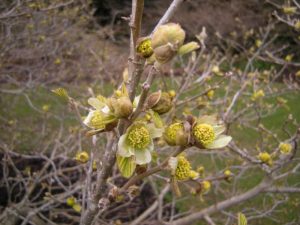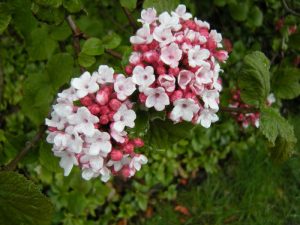The deciduous woody shrub Parrotiopsis jacquemontiana is a member of the Hamamelidaceae family and hails from the Himalayas. Plants are found growing in the north-west frontier province of Pakistan on west facing slopes with scree at 2700 to 2980 metres.
The terminal brown felted buds open slowly to reveal the conglomerate mass of flowers, of which the yellow anthers are prominent. Further opening of the bracts reveals the inner white colour. The combined flowering gives a light appearance to the mass of twigs. At this time the new leaves are forcing through at the corners of the flowers. Planted near the road edge within the Hamamelis collection, the twiggy mass is flowering well this year. The individual flowers are relatively attractive but don’t expect the seductive scent that the Hamamelis plants provided. It’s not a thing of beauty when in flower but will attract the botanically interested.
For a delightful scent and showy blooms, walk over to the Demonstration Garden, here Viburnum carlesii ‘Aurora’ is changing from tight red bud to open white blooms. The scent thrown out from the rounded cymes by a mature plant on a warm day is exceptional.
The species is native to Korea and Japan’s Tsushima Island, in the Korean Strait from where seed was sent to Slieve Donard Nursery in Northern Ireland. Here Leslie Slinger selected out seedlings and introduced ‘Aurora’ to the trade in 1958. It received a well deserved Award of Garden Merit from the RHS in 1984.
Our plant is a very good form, displaying a mass of flowers. In bud, they are carmine red and on opening they’re white tinged pink. Within some of the individual flowers the anthers are prominent, on others subtended. The stigma lies at the base of the tube red in colour.
Leaf growth and development is well advanced, highlighting the flower colour. The plant has a rounded shape with vigorous water shoots arising from its centre.


